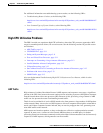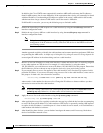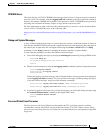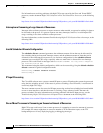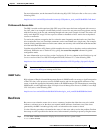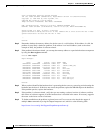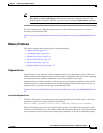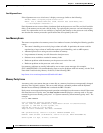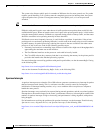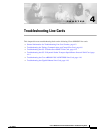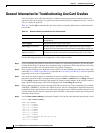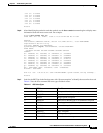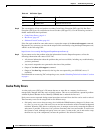
3-17
Cisco uBR10012 Universal Broadband Router Troubleshooting Guide
OL-1237-01
Chapter 3 Troubleshooting PRE-1 Modules
Troubleshooting Common System Problems
System returned to ROM by processor memory parity error at PC 0x60301298, address 0x0 at
17:19:47 PDT Mon Dec 15 2003
System restarted at 17:19:47 PDT Mon Dec 15 2003
...
Router#
Parity errors can be categorized in two different ways:
• Soft parity errors occur when an energy level within the DRAM memory changes a bit from a one
to a zero, or a zero to a one. Soft errors are rare and are most often the result of normal background
radiation. When the CPU detects a soft parity error, it attempts to recover by restarting the affected
subsystem, if possible. If the error is in a portion of memory that is not recoverable, it could cause
the system to crash. Although soft parity errors can cause a system crash, you do not need to swap
the board or any of the components, because the problem is not defective hardware.
• Hard parity errors occur when a hardware defect in the DRAM or processor board causes data to be
repeatedly corrupted at the same address. In general, a hard parity error occurs when more than one
parity error in a particular memory region occurs in a relatively short period of time (several weeks
to months).
When parity occurs, take the following steps to resolve the problem:
Step 1 Determine whether this is a soft parity error or a hard parity error. Soft parity errors are 10 to 100 times
more frequent than hard parity errors. Therefore, wait for a second parity error before taking any action.
Monitor the router for several weeks after the first incident, and if the problem reoccurs, assume that the
problem is a hard parity error and proceed to the next step.
Step 2 When a hard parity error occurs (two or more parity errors at the same memory location), try removing
and reinserting the PRE-1 module, making sure to fully insert the card and to securely tighten the
restraining screws on the front panel.
Step 3 If this does not resolve the problem, remove and reseat the DRAM chips. If the problem continues,
replace the DRAM chips.
Step 4 If parity errors occur, the problem is either with the PRE-1 module or the router chassis. Replace the
PRE-1 module.
Step 5 If the problems continue, contact Cisco TAC for further instructions.
For more information about parity errors, see the Processor Memory Parity Errors document, at the
following URL:
http://www.cisco.com/en/US/products/hw/routers/ps341/products_tech_note09186a0080094793.shtml
Particle Pool Fallbacks
Private particle pools are buffers in I/O memory that store packets while they are being processed. The
Cisco IOS software allocates a fixed number of private particle pools during system initialization, and
these buffers are reserved for packet use, so as to minimize system contention for memory resources.
The system uses buffer control structures called “rings” to manage the entries in the particle pools. Each
ring is a circular linked-list of pointers to each packet in the particle pool. The system creates a pair of
rings for each interface, with one ring for packets waiting to be transmitted and another ring for packets
that are being received.



